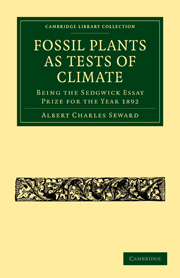Book contents
- Frontmatter
- PREFACE
- Contents
- Introduction
- Chapter I HISTORICAL SKETCH
- Chapter II PLANT DISTRIBUTION
- Chapter III PLANTS AND LOW TEMPERATURES: ARCTIC VEGETATION
- Chapter IV THE INFLUENCE OF EXTERNAL CONDITIONS UPON THE MACROSCOPIC AND MICROSCOPIC STRUCTURES OF PLANTS
- Chapter V ANNUAL RINGS IN RECENT AND FOSSIL PLANTS
- Chapter VI ARCTIC FOSSIL PLANTS
- Chapter VII CARBONIFEROUS PERIOD
- Chapter VIII PLEISTOCENE PLANTS AND CONCLUSION
- List of Works referred to in the Text
- Index
Chapter III - PLANTS AND LOW TEMPERATURES: ARCTIC VEGETATION
Published online by Cambridge University Press: 07 September 2010
- Frontmatter
- PREFACE
- Contents
- Introduction
- Chapter I HISTORICAL SKETCH
- Chapter II PLANT DISTRIBUTION
- Chapter III PLANTS AND LOW TEMPERATURES: ARCTIC VEGETATION
- Chapter IV THE INFLUENCE OF EXTERNAL CONDITIONS UPON THE MACROSCOPIC AND MICROSCOPIC STRUCTURES OF PLANTS
- Chapter V ANNUAL RINGS IN RECENT AND FOSSIL PLANTS
- Chapter VI ARCTIC FOSSIL PLANTS
- Chapter VII CARBONIFEROUS PERIOD
- Chapter VIII PLEISTOCENE PLANTS AND CONCLUSION
- List of Works referred to in the Text
- Index
Summary
In attempting to picture to ourselves the conditions which obtained during the Glacial period, it is frequently forgotten that a very low temperature is not of that importance which it is often considered to be in bringing about an Ice Age.
Wallace and many others have laid stress on the necessity for a concurrence of several conditions in order to render possible an abnormal extension of snow and ice.
Whitney, in his comprehensive monograph on The climatic changes of later geological times, has argued for the possibility of the former extension of snow and ice without any violent changes in climatic conditions.
After considering the question at length he remarks, “The entire body of facts presented brings out most clearly the true condition of things, namely, that the Glacial epoch was a local phenomenon, during the occurrence of which much the larger of the land-masses of the Globe remained climatologically entirely unaffected.” As illustrating the possibility of glaciers existing in places whose mean temperatures differ by several degrees we may notice some observations given by Woeikof. He shews clearly how other conditions than merely a low temperature are essential to ice extension. Comparing the temperatures taken at the lower ends of glaciers in East Siberia and the West of New Zealand, there is found to be a difference of more than 20°: at Irkutsk in East Siberia the temperature recorded being – 102°, in New Zealand 10°.
- Type
- Chapter
- Information
- Fossil Plants as Tests of ClimateBeing the Sedgwick Essay Prize for the Year 1892, pp. 44 - 54Publisher: Cambridge University PressPrint publication year: 2009First published in: 1892



